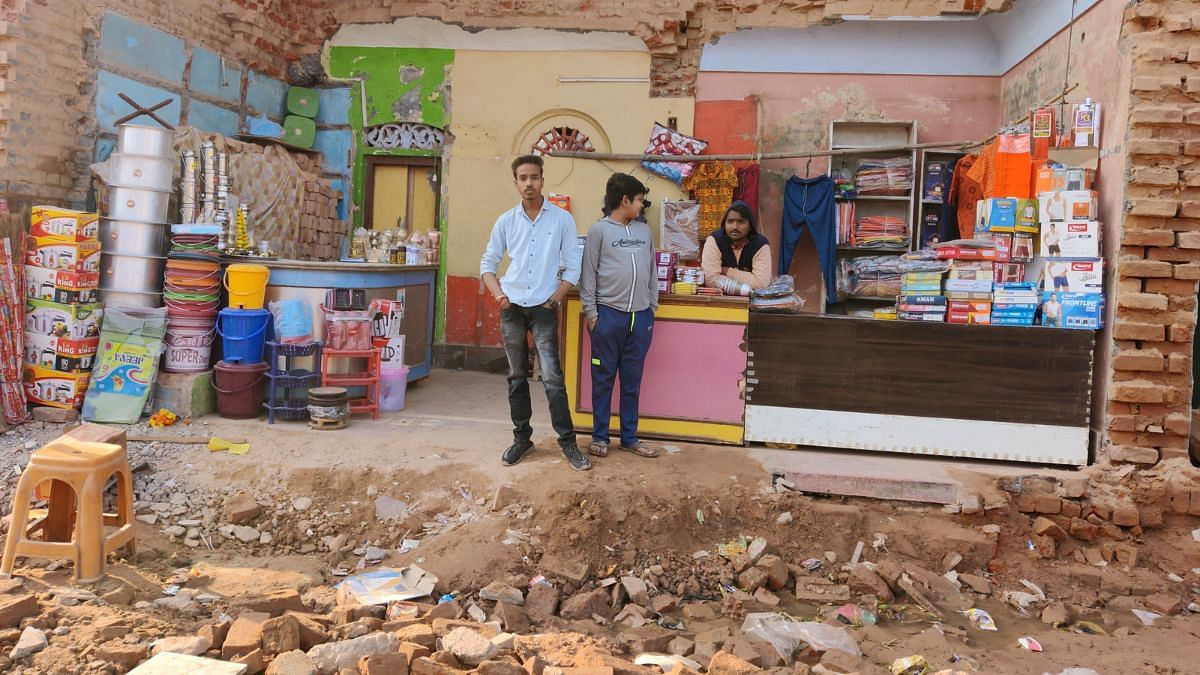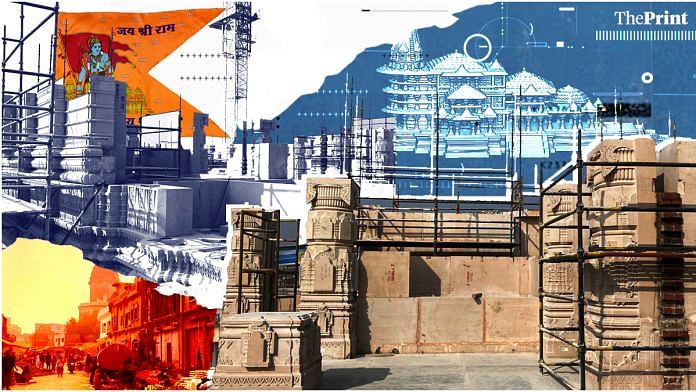Ayodhya: The temple town of Ayodhya in Uttar Pradesh is in a state of transition. By around this time next year, it must be ready to welcome devotees visiting the Ram Mandir for darshan of the Ram Lalla idol in the temple’s garbhagriha, or sanctum sanctorum.
Last week, ThePrint visited the 70-acre site, where the hectic pace of work conveys a sense of urgency. Not only is construction 45 per cent complete, but the trust set up to oversee the building of the Ram Mandir and its management has raised funds almost double the construction cost by way of contributions and donations from people.
Speaking to ThePrint, Dr Anil Mishra, one of the trustees of the Shri Ram Janmabhoomi Teerth Kshetra trust, said that work is on track and by Makar Sankranti in January 2024, the idol of Lord Ram will have been installed and the garbhagriha thrown open to devotees.
At the temple site, around 550 workers of L&T Construction, which is executing the project, are hard at work pretty much round the clock. Simultaneously, in neighbouring Rajasthan, another 1,000 men are working to mine and carve the pink sandstone that will be used for the main structure of the temple.
Not just within the complex, but in most parts of Ayodhya, some construction project or the other is on — the town is preparing for 2024. The target is to complete the entire temple complex by 2025.

As of now, work has been completed till the ground floor of the temple, V.K. Mehta, project director, L&T, said, “We have completed around 45 per cent of the total construction,” adding that the ground floor of the temple will house the garbhagriha. “On the upper floor, the trust is planning to have a Ram Darbar.”
The temple complex will include the Ram Mandir; temples of six other deities including Valmiki, Vashisht and Sabari; a pilgrim facilitation centre; a herbal garden; and facilities including an electric substation, a sewage treatment plant and water treatment plant.
Construction of the entire complex is expected to cost anywhere between Rs 1,800 and Rs 2,000 crore, according to Anil Mishra. “The mandir alone will cost Rs 550 crore… It’s difficult to give a final estimate at present because costs may go up during construction,” he said, adding that the temple trust has received Rs 3,200 crore through contributions and donations.
Nripendra Misra, who heads the trust, told ThePrint that the trust has not taken a penny of government money to build the temple. “We have received contributions from devotees which are being used. We are on schedule. The work is being reviewed on a daily basis by on-ground staff. Every month, we (members of the trust) make a three-day visit to Ayodhya to review progress,” he said.
Also Read: Ayodhya judgment protest ‘can’t be taken lightly’, promotes religious enmity, says Karnataka HC
161-ft-high temple, built over 2.77 acres
While huge granite blocks sourced from Karnataka have been used for flooring, the main structure of the temple will be made of approximately 4.70 lakh cubic feet of carved pink sandstone being procured from Rajasthan’s Bharatpur district.
After the sandstones are mined, they are taken to a workshop in Rajasthan’s Sirohi district for carving.
“The sandstones are being carved there and, after proper packing, being transported to Ayodhya where we are assembling it,” said Mehta.
The 161-foot-high temple, which will have three floors, each 19.5 feet high, will be built over 2.77 acres. “The ground floor will have the garbhagriha area. The other floors are just to create the altitude of the temple…. The temple’s length is around 344 feet and width, 250 feet. Nowadays, any temple being built in the country is one of the biggest and tallest,” added Mehta.
A complete facelift for the town
State government officials told ThePrint that plans are being made to transform Ayodhya into what can be called the ‘Vatican for Hindus’, showcasing the ethos of the Hindu religion and culture, ahead of the 2024 Lok Sabha election.
From a greenfield township, a swanky railway station, and a new airport of international standards, to a network of four-lane highways and a road to connect the Ram Temple directly with the highway — massive work is underway.
The Ayodhya Development Authority (ADA) has taken up the work of beautifying eight of the city’s mythological ponds, including the ancient Surya Kund, and the ghats here. ADA vice-chairman Vishal Singh said that they are expecting anywhere between 50,000 and one lakh devotees daily once the temple is thrown open to devotees.
“We are working on a multi-pronged strategy for when the temple is opened. A lot of work has begun. Open wires are being replaced with underground cables, several multi-level parking facilities are being built across the city, drinking water facilities and washrooms are being developed,” Singh said.
The ADA has already completed one parking complex that can accommodate up to 5,000 vehicles. “We are creating space for a food court, dormitories, locker rooms in all multi-level car parking areas. We are also building huge welcome centres at the entrances to the city, at six sites from where people can come by road. The idea is to give pilgrims a hassle-free experience,” Singh added.
A swanky new railway station, being developed by Rail India Technical and economic Service Limited (RITES), a subsidiary of Indian Railways, is almost ready. The Rs 240-crore station that resembles an airport has the capacity to hold 15,000 passengers at a time. “There are AC retiring rooms where a total of 104 passengers can stay besides other basic amenities. Work will soon start on an air concourse coming up at the station complex. The station will be opened from December 2023,” said A.K. Johri, joint general manager, RITES.
The airport, added Singh, is expected to be ready before 2024.
Also Read: Mayor, MLA, officials, their kin rushed to buy land in Ayodhya after Ram temple verdict: Report
‘Development is good, but give adequate compensation to affected business owners’
Massive redevelopment work is also ongoing in the localities adjoining the temple complex.
The civic authorities have demolished buildings comprising mostly shops in areas such as Hanumangarhi to widen the existing narrow road leading to the temple. “The existing roads are very congested and it’s difficult to walk during rush hours. The district administration is widening the approach roads,” Singh said.
Residents and business owners whose shops have been demolished in the process are not happy. Though they welcome the development work going on to transform Ayodhya into an international pilgrimage centre, they are demanding adequate compensation.

Dipu Gupta’s family was running a provisional store in Hanumangarhi for three generations, but last month their shop was demolished to make way for the widening of the road. “The road widening was necessary. I do not have an issue with that, but the compensation I have received is a pittance,” said Dipu Gupta.
According to him, a mere two feet of the shop was spared. “I have got compensation of Rs 1.70 lakh. It’s next to nothing. I have spent more money on constructing the new shop,” he said.
Ramji Gupta, who used to run an electronics shop in the area, is another aggrieved resident. “I agree things would improve once the construction work is completed, but my shop has been closed for six months. I do not have any income currently. The authorities should have earmarked some sort of income for this period,” he said.
(Edited by Zinnia Ray Chaudhuri)
Also Read: Ram Mandir to Ram Rajya — RSS begins work for its roadmap for next 25 years



